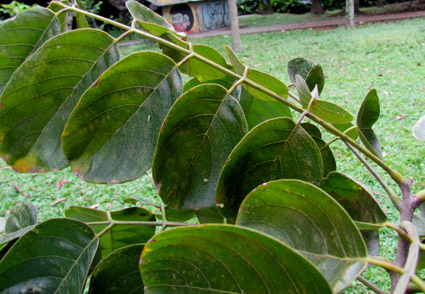Abstract
A new species of Dahlstedtia from Colombia is described and illustrated with notes about its geographical distribution, phenology, conservation status and taxonomic affinities. Dahlstedtia colombiana shares with D. muehlbergiana their leaves often with 9–11 opposite leaflets, leaflets abaxially silky as well as wide samaroid fruits coriaceous to woody, indumented with few seeds. However, the new species can be distinguished by its leaflet bases truncate to rounded, leaflet secondary veins not reaching at the secondary marginal vein, shorter secondary bracts and bracteoles, longer flowering pedicels, and its fruits silky and khaki colored. Dahlstedtia colombiana inhabits the Seasonally Tropical Dry Forest in the Cauca and Magdalena Rivers Valleys, a highly disturbed ecosystem inside the country. This new species represents the first record of Dahlstedtia from Colombia although other species have been recorded from all neighboring countries. Some specimens of D. colombiana were collected on an unknown date between the ending of the 18th and beginning of the 19th centuries in the expedition led by Jose Celestino Mutis, which geographical provenance is briefly discussed here.
References
- Beentje, H. (2016) The Kew Plant Glossary: An Illustrated Dictionary of Plant Identification Terms, ed. 2. Royal Botanic Gardens, Kew.
- Bentham, G. (1862) Leguminosae I. Papilionaceae, Dalbergieae. In: von Martius, C.F.P. & Fenzi, E. (Eds.) Flora Brasiliensis. Vol. 15, part 1. F. Fleischer, Monachii & Lipsiae, pp. 217–350.
- Bernal, R. (2016) Geografía de Colombia. In: Bernal, R., Gradstein, S.R. & Celis, M. (Eds.) Catálogo de Plantas y Líquenes de Colombia Vol. 1. Instituto de Ciencias Naturales, Universidad Nacional de Colombia, Bogotá, pp. 19–32.
- Burkart, A. (1957) Leguminosas nuevas o críticas, V. Darwiniana 11 (2): 256–271.
- Dauby, G. (2019) ConR: Computation of Parameters Used in Preliminary Assessment Conservation Status. R package version 1.2.4. [https://CRAN.R-project.org/package=ConR]
- DRYFLOR. (2016) Plant diversity patterns in Neotropical dryforests and their conservation implications. Science 353 (6306): 1383–1387. https://doi.org/10.1126/science.aaf5080
- Ellis, B., Daly, D.C., Hickey, L.J., Johnson, K.R., Mitchell, J.D., Wilf, P. & Wing, S.L. (2009) Manual of Leaf Architecture. 1st ed. Cornell University Press, Ithaca, New York, 190 pp. https://doi.org/10.1079/9781845935849.0000
- García, H., Corzo, G., Isaacs, P. & Etter, A. (2014) Distribución y estado actual de los remanentes del bioma de bosque seco tropical en Colombia: Insumos para su gestión. In: Pizano, C. & García, H. (Eds.) El bosque seco tropical en Colombia. Instituto de Investigación de Recursos Biológicos Alexander von Humboldt (IAvH), Bogotá, pp. 229–251.
- Hassler, E. (1907) Deux Lonchocarpus nouveaux des campos du Paraguay, Bulletin de l’Herbier Boissier, sér. 2, 7: 164–167.
- Harms, H.A.T. (1926) Leguminosae. In: Mildbraed (Ed.) Plantae Tessmannianae peruvianae III. Notizblatt des Botanischen Gartens und Museums zu Berlin-Dahlem, Vol. 9. pp. 966–976. https://doi.org/10.2307/3994448
- Hermann, F.J. (1949) New species of Lonchocarpus from Panama. Annals of the Missouri Botanical Garden 36: 281–284. https://doi.org/10.2307/2394395
- Hewson, H.J. (2019) Plant Indumentum: A Handbook of Terminology, revised edition. Australian Biological Resources Study, Commonwealth Department of the Environment and Energy, Canberra, 47 pp.
- IUCN. (2012) IUCN Red List Categories and Criteria: Version 3.1. Second edition. IUCN Species Survival Commission. IUCN, Gland, Switzerland and Cambridge, U.K.
- Kunth, C.S. (1824) Lonchocarpus. In: Humboldt, F.W.H.A. von, Bonpland, A.J.A. & Kunth, C.S. (Eds.) Nova Genera et Species Plantarum 6. Gide Filium, Paris, pp. 383–385.
- Linnaeus, C. f. (1781 [1782]) Supplementum Plantarum Systematis Vegetabilium Editionis Decimae Tertiae, Generum Plantarum Editionis Sextae, et Specierum Plantarum Editionis Secundae. Braunschweig, 468 pp. https://doi.org/10.5962/bhl.title.555
- Malme, G.O. (1905) Dahlstedtia, eine neue Leguminosen-Gattung. Arkiv för Botanik 4 (9): 1–7. https://doi.org/10.1002/fedr.19050010804
- Pennington, R.T, Lavin, M., Oliveira-Filho, A. (2009) Woody plant diversity, evolution, and ecology in the tropics: Perspectives from seasonally dry tropical forests. Annual Review of Ecology, Evolution and Systematics 40: 437–457. https://doi.org/10.1146/annurev.ecolsys.110308.120327
- Pérez-Arbeláez, E. (1983) José Celestino Mutis y la Real Expedición Botánica del Nuevo Reyno de Granada. Instituto Colombiano de Cultura Hispánica, Ediciones del segundo Centenario de la Real Expedición Botánica. Editorial Linotipia Bolivar Ltda, Bogotá, 235 pp.
- Protected Planet. (2019) The World Data Base on Protected Areas. Available from: https://www.protectedplanet.net/ (accessed 25 September 2024)
- R Core Team. (2019) R: A language and environment for statistical computing. Available from: https://www.R-project.org/ (accessed 25 September 2024)
- Silva, M.J. (2010) Filogenia e Biogeografia de Lonchocarpus s.l. e Revisão Taxonômica dos géneros Muellera L. f. e Dahlstedtia Malme (Leguminosae, Papilionoideae, Millettieae). Tese de Doutorado. Campinas, Universidade Estadual de Campinas.
- Silva, M.J., Queiroz, L.P., Tozzi, A.M.G.A, Lewis, G.P. & Sousa, A.P. (2012) Phylogeny and biogeography of Lonchocarpus sensu lato and its allies in the tribe Millettieae (Leguminosae, Papilionoideae). Taxon 61 (1): 93–108. https://doi.org/10.1002/tax.611007
- Silva, M.J. & Tozzi, A.M.G.A. (2012a) Three new species, a new combination, and a neotypification in Dahlstedtia (Leguminosae, Millettieae, Papilionoideae) from South America. Brittonia 64 (4): 268–276. https://doi.org/10.1007/s12228-012-9242-4
- Silva, M.J. & Tozzi, A.M.G.A. (2012b) Revisão taxonômica de Lonchocarpus s. str. (Leguminosae, Papilionoideae) do Brasil. Acta Botanica Brasilica 26 (2): 357–377. https://doi.org/10.1590/S0102-33062012000200012
- Taubert, P. (1889) Leguminosae novae v. minus cognitae austro-americanae. Flora oder Botanische Zeitung: welche Recensionen, Abhandlungen, Aufsätze, Neuigkeiten und Nachrichten, die Botanik betreffend, enthält 72: 421–430.
- Taubert, P. (1894) Leguminosae. In: Engler, A. & Prantl, K. (Eds.) Die natürlichen Pflanzenfamilien III. Vol 3. Wilhelm Engelmann, Leipzig, pp. 70–384.
- Thiers, B. (2016 onward) Index herbariorum: a global directory of public herbaria and associated staff. New York Botanical Garden’s Virtual Herbarium. The New York Botanical Garden, Bronx, New York.
- Tozzi, A.M.G.A. (1995) New species of Lonchocarpus Kunth (Leguminosae: Papilionoideae: Millettieae) from Brazil. Kew Bulletin 50 (1): 173–177. https://doi.org/10.2307/4114627
- Tropicos.org. (2022) Missouri Botanical Garden, St. Louis, Missouri. Available from: https://tropicos.org (accessed 19 January 2022)


